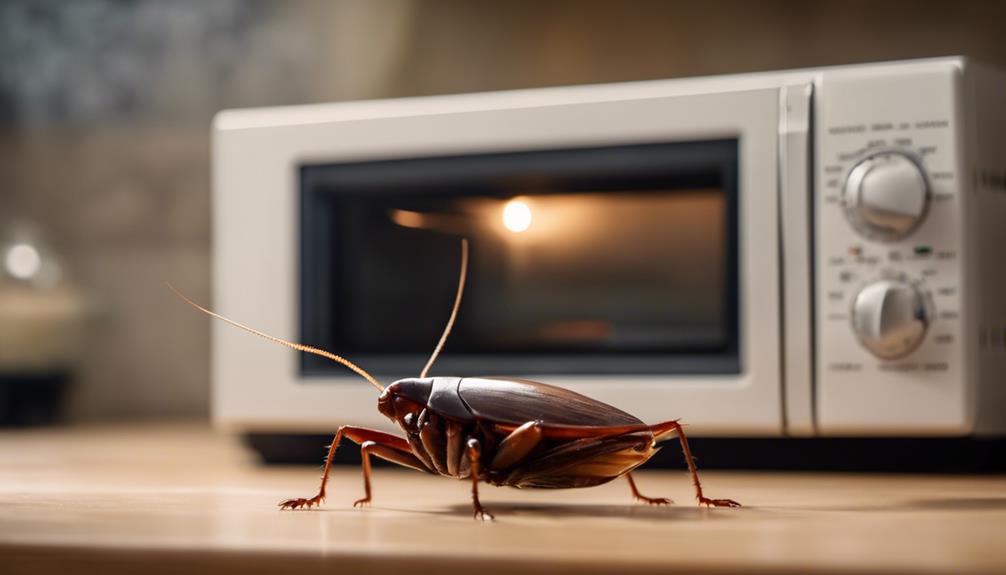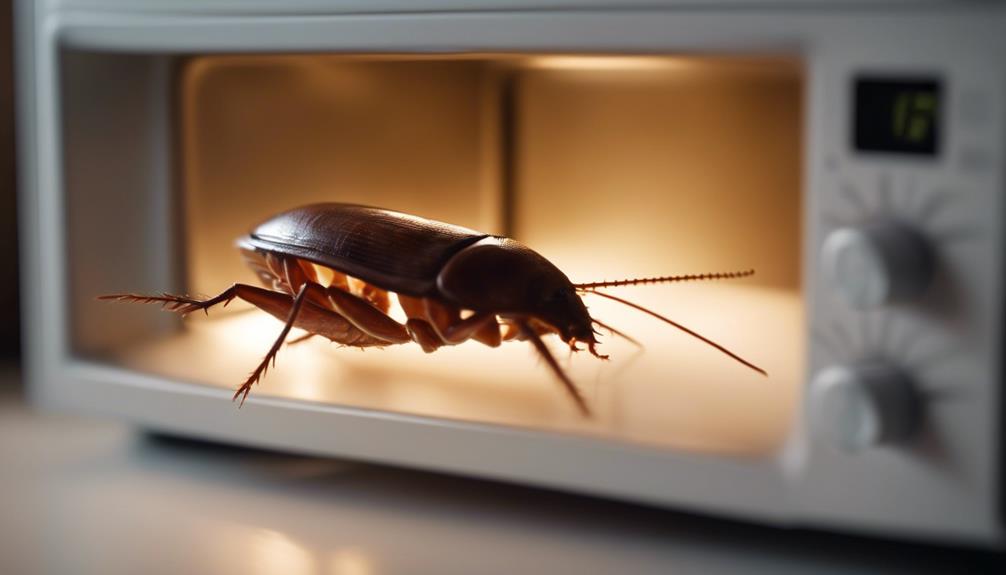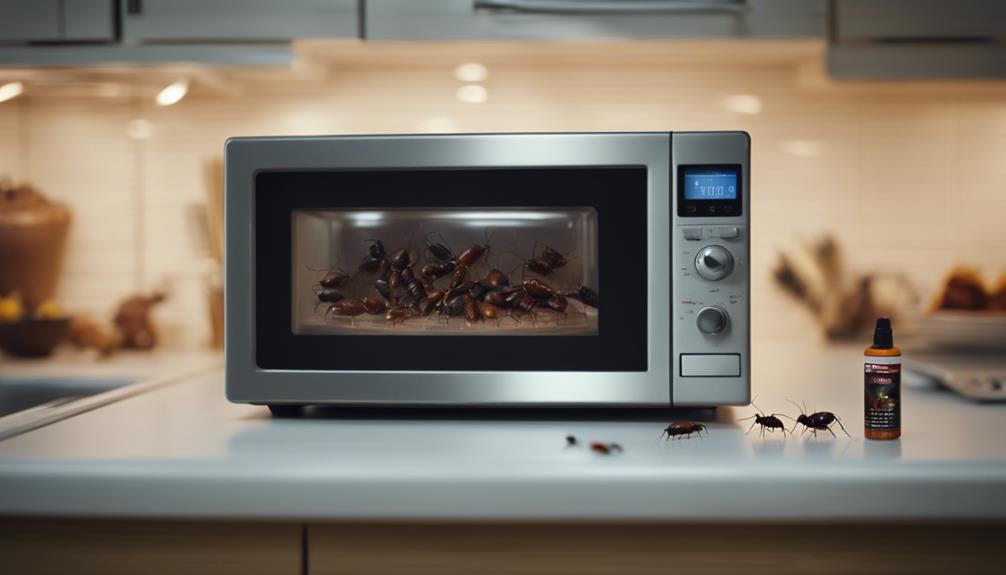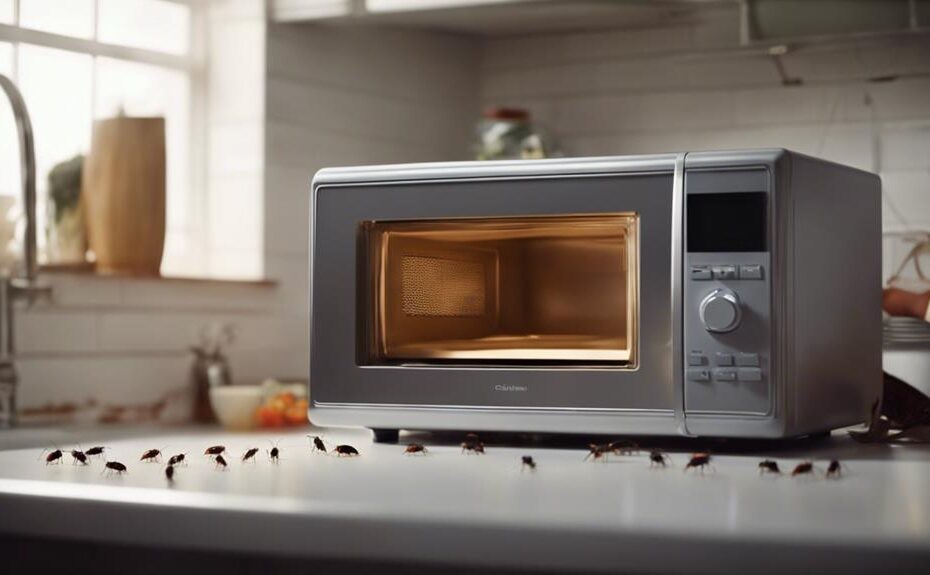The discovery of cockroaches in a microwave can raise various questions regarding safety, hygiene, and practicality. One may wonder about the consequences of such an encounter, both for the appliance and the pests themselves.
The behavior of cockroaches in the confined space of a microwave, as well as the potential effects of microwave radiation on these insects, present intriguing considerations that delve beyond the surface. This scenario prompts an exploration into the myths surrounding microwaving cockroaches and offers insights into alternative methods for addressing pest control challenges.
Microwave Safety Concerns

Microwave safety concerns encompass a range of potential hazards and precautions that users should be mindful of to ensure safe and effective operation of this kitchen appliance. One major concern is radiation exposure. Microwaves emit electromagnetic radiation to cook food, and while modern microwaves are designed with safety features to prevent leakage, damaged doors or seals can result in exposure. It is crucial to maintain the integrity of the microwave door and have it repaired promptly if any issues arise to prevent harmful radiation exposure.
Another important safety consideration is food contamination. Improperly sealed containers or food packaging can lead to steam build-up and potential explosions, causing burns or spreading harmful bacteria. It is vital to use microwave-safe containers and follow guidelines for venting steam to avoid accidents. Additionally, regular cleaning of the microwave interior is essential to prevent the buildup of food residues that can harbor bacteria and lead to contamination. By being aware of these safety concerns and taking necessary precautions, users can minimize risks associated with microwave usage.
Cockroach Behavior in Microwave
The presence of cockroaches in kitchen appliances poses a potential health and safety concern due to their behavior patterns and the risk of contamination they introduce. When exposed to a microwave, cockroaches exhibit distinct reactions that can be observed through controlled experiments.
Microwave experiments involving cockroaches have shown that these pests display erratic movements and increased activity levels when subjected to microwave radiation. In some cases, cockroaches may attempt to flee the microwave, while in others, they curl up or show signs of distress. These reactions suggest that cockroaches are capable of sensing and responding to the microwave's electromagnetic fields.
Understanding cockroach behavior in microwaves is important not only for pest control purposes but also for assessing the risks associated with their presence in kitchen appliances. Further research into the mechanisms underlying these reactions could lead to more effective methods for managing cockroach infestations and preventing potential health hazards.
Effects of Microwave on Cockroaches

Cockroaches' responses to exposure to microwave radiation provide valuable insights into the physiological effects of this type of electromagnetic field on these pests. When microwaved, cockroaches exhibit various reactions that can help us understand the impact of microwave radiation on living organisms. Below is a table summarizing some common roach reactions when exposed to microwaves:
| Roach Reactions | Description | Effects |
|---|---|---|
| Increased movement | Pests may show heightened activity | May lead to disorientation |
| Decreased activity | Some cockroaches become lethargic | Could indicate stress |
| High mortality rate | Microwaved pests might die quickly | Shows potential harm |
Understanding these reactions is crucial for comprehending the effects of microwave radiation on cockroaches and potentially applying this knowledge to pest control strategies. Further research is needed to explore the long-term consequences of microwave exposure on these insects.
Myth Busting: Microwaving Cockroaches
An examination of the common beliefs surrounding the practice of microwaving cockroaches reveals the need for a scientific evaluation of the purported outcomes. In the realm of pest management, urban legends often circulate about unconventional methods to eradicate cockroach infestations, one of which includes microwaving them. However, it is crucial to debunk such myths and rely on evidence-based approaches for effective pest control.
Microwaving cockroaches is not a recommended method for pest management. While it may kill individual cockroaches subjected to microwave radiation, the effectiveness of this method in eliminating an entire infestation is questionable. Cockroaches are known for their resilience and ability to adapt to harsh conditions, making it unlikely that microwaving them would significantly impact a population within a home or building.
Alternatives to Microwave for Pest Control

Exploring alternative methods for pest control beyond the use of microwave radiation presents a diverse range of scientifically-backed approaches to effectively manage cockroach infestations. When considering alternatives to microwaving cockroaches, natural remedies and electronic repellents stand out as popular options. Natural remedies such as diatomaceous earth, essential oils like peppermint and cedarwood, as well as boric acid, offer non-toxic solutions that are safe for both humans and pets. These substances work by dehydrating the exoskeleton of cockroaches or interfering with their respiratory systems, ultimately leading to their demise.
On the other hand, electronic repellents utilize ultrasonic or electromagnetic technology to deter pests like cockroaches from infesting a space. These devices emit high-frequency sound waves or pulses that are intolerable to pests but imperceptible to humans. While the effectiveness of electronic repellents may vary depending on factors like the type of device and the layout of the area, they provide a chemical-free and environmentally friendly approach to pest control.
| Natural Remedies | Electronic Repellents |
|---|---|
| Diatomaceous earth | Ultrasonic devices |
| Essential oils | Electromagnetic devices |
| Boric acid | Sonic repellents |
Frequently Asked Questions
Can Microwaving Cockroaches Spread Diseases or Bacteria in the Microwave?
Microwaving can spread diseases through improper sanitation, especially with food. To ensure microwave cleanliness and prevent disease transmission, proper pest control measures should be taken.
Regular cleaning, including wiping down surfaces and using microwave-safe covers, can help maintain food safety. It is essential to follow guidelines for microwave sanitation to reduce the risk of bacterial contamination and ensure a healthy environment in food preparation areas.
Are There Any Long-Term Health Risks Associated With Using a Microwave That Has Had Cockroaches in It?
Health implications related to using a microwave previously inhabited by cockroaches can be significant. The presence of pests in such appliances raises concerns about cleanliness and hygiene practices.
Long-term risks may arise from potential contamination of food items with bacteria or pathogens carried by the insects. To ensure microwave safety and mitigate health hazards, thorough cleaning, disinfection, and regular maintenance are crucial.
A vigilant approach to hygiene practices can help prevent any adverse health effects.
How Do Cockroaches Survive in a Microwave When Other Insects Cannot?
Cockroaches can survive in extreme conditions due to their adaptable biology. The ability of these insects to withstand microwave exposure, unlike many other insects, is attributed to their resilient physiology, including a sturdy exoskeleton, efficient nervous system, and ability to regulate body temperature.
Understanding cockroach behavior and survival mechanisms can aid in implementing effective pest control measures. When considering microwave safety, it is crucial to maintain cleanliness and promptly address any pest infestations to prevent potential health hazards.
Can Microwaving Cockroaches Attract More Cockroaches Into Your Home?
Microwaving cockroaches does not inherently attract more cockroaches into a home.
However, the presence of cockroaches in general can lead to increased cockroach activity due to their pheromones signaling other roaches.
To prevent this, proper pest control measures should be employed, including sealing entry points, eliminating food sources, and implementing regular sanitation practices.
These strategies help deter cockroaches and minimize the likelihood of attracting more into the home.
Are There Any Non-Toxic Methods for Getting Rid of Cockroaches That Are as Effective as Using a Microwave?
Like a beacon guiding ships to shore, natural remedies offer effective alternatives to eliminate cockroaches without toxicity. DIY traps, such as boric acid, essential oils, or a mixture of baking soda and sugar, can be as potent as using a microwave.
These methods exploit the insects' behavior and biology to achieve successful control. When implemented correctly, these non-toxic approaches can significantly reduce cockroach populations in your home.
Conclusion
In conclusion, microwaving cockroaches may not be an effective method of pest control as it can lead to safety concerns and potential harm to the microwave.
It is important to explore alternative pest control methods that are more humane and effective in managing cockroach infestations.
Remember, prevention is key in maintaining a pest-free environment.

